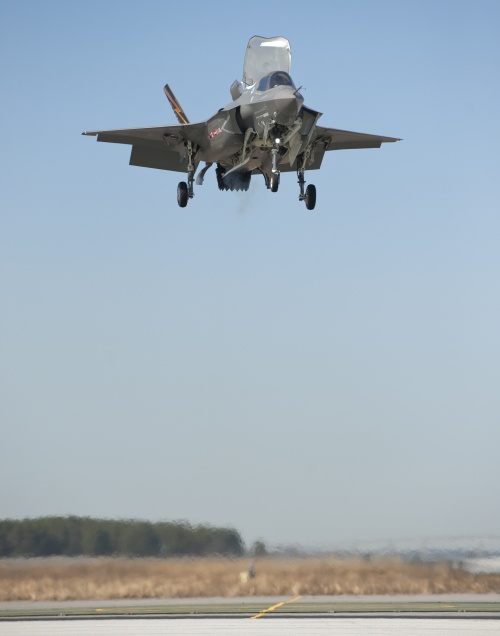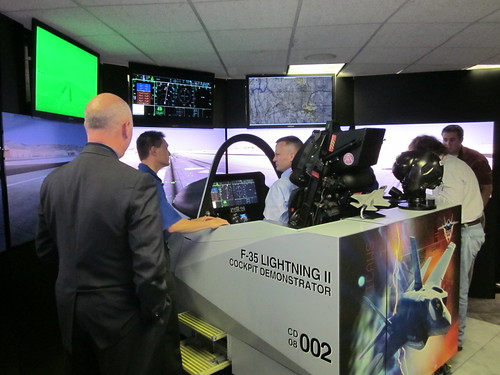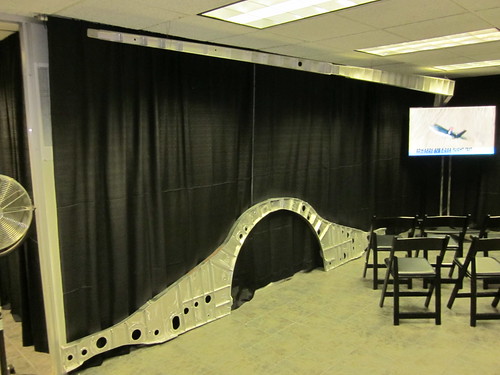A virtual ride on the F-35
On Thursday, I drove down to Oklahoma City, to Pro-Fab, Inc., for a briefing and a short flight in a cockpit demonstrator for the new F-35 Lightning II, the Joint Strike Fighter built by Lockheed Martin Aerospace in Fort Worth, in partnership with Northrup Grumman, BAE, Pratt & Whitney, and hundreds of smaller suppliers like Pro-Fab.
The event was part of a tour, bringing the cockpit demonstrator (a fixed-base simulator that can be transported in a semi trailer) and Lockheed Martin officials to the sites of suppliers and military bases around the US and in the nine partner nations. The point of the tour is to thank suppliers for their contribution to the success of the F-35 program and to educate supplier staff and local elected officials about the F-35's contribution to the local economy. After the presentation, State Rep. Colby Schwartz took the first ride in the cockpit demonstrator.
Pro-Fab, located on the western edge of Oklahoma City, south of Lake Overholser, employs about 150 people, producing ultra-precise machining for the military and civil aerospace industry. 60 to 70 are involved in work for the F-35, producing wing spars, bulkheads, pins, and specialty bolts from materials like titanium and aluminum.
Pro-Fab is one of seven F-35 suppliers in Oklahoma. According to Pro-Fab program manager Ryan Russo, aerospace employs 150,000 Oklahomans, is the state's number one export industry, producing 10% of the state's output.
The F-35 is designed to serve several different missions for the three services that fly fixed-wing aircraft -- Air Force, Navy, Marine Corps. The plan is for 2400 F-35s in three variants to replace the F-16 Fighting Falcon, A-10 Thunderbolt II, AV-8B Harrier II, and older (A-D) variants of the F/A-18 Hornet. The Air Force will fly the conventional takeoff-and-landing F-35A, the Marines will fly the short-takeoff, vertical-landing F-35B, and the Navy will fly the carrier variant, the F-35C with beefed-up landing gear for their routine controlled crashes onto the carrier deck.
Despite the differences in airframe and engines, the three variants have identical cockpits. It's something of a coup to get the zoomies, jarheads, and squids all on the same page when it comes to cockpit layout. Maximizing the number of common components between the three variants should reduce the cost of keeping the aircraft flying over decades to come. There are huge savings to be found in replacing four different aircraft from three different manufacturers, with all the distinct parts, tooling, and skilled technicians required to maintain them, with one aircraft, able to use common parts, tooling, and technicians for all three variants.
Another advantage of the common cockpit is that a simulator can be used to train any of the three variants without any delay to swap out hardware or run a different software program.
The F-35 replaces aircraft nearing the end of their design life, increasingly difficult to support. The A-10 came online in 1976, the F-18 came online in 1978, the F-16 in 1979, and the AV-8B in 1984.
During the presentation, we heard from two Lockheed Martin officials, Daniel Conroy, director of the F-35 program, and Graham Tomlinson, test pilot. Conroy highlighted the improved stealth capabilities of the F-35. Although he didn't draw an explicit comparison to first generation stealth aircraft like the B-2 and the now-retired F-117A, he said that the F-35 has ruggedized stealth -- it doesn't have to be treated with kid gloves.
Tomlinson, an RAF veteran, drew analogies from the world of Harry Potter -- stealth was the F-35's "cloak of invisibility" and the cockpit display was the pilot's "Marauder's Map," synthesizing information about friendly and enemy aircraft from both the aircraft's own sensors and location data transferred over secure datalink from other fighters or AWACS in the battlespace. In current generation fighters like the F-16, the pilot was required to combine in his head his own observations from radar and other sensors, observations from his wingmen and AWACS, communicated by radio. The result can be what Conroy called a "helmet fire" -- pilot information overload. In the F-35, he can see on his screen where the bad guys are and which targets have already been claimed by his wingmen.
Tomlinson compared the "ridiculous" ease of flying the F-35B STOVL to the "tricky" complexity of the AV-8B Harrier II it is due to replace. The Harrier requires three hands to fly, he said -- stick, throttle, and nozzle control. Thanks to fly-by-wire controls, computers allow the F-35B pilot to handle normal flight, hover/vertical landing, and the transition between the two in an intuitive way using just throttle and stick.

For my turn in the cockpit demonstrator, I flew a carrier takeoff, flew 90-degree bank, 7 G turns to sneak up on the bad guys, shot down two enemy aircraft, did a celebratory aileron roll, and stuck the landing on the carrier. I was impressed with how easy it all was.
On the carrier landing, graphics on the heads-up display showed me exactly where I needed to aim, as I lined up the aircraft icon with the landing point on the approach. To pick a target, I touched the screen to show a display with aircraft in the area, used a cursor on the throttle to designate a target, then hit the red button on the stick. I watched the missile track and kill the target, then the display showed the aircraft's cameras' zoomed view of the target's fall from the heavens.
Engine instruments and caution lights, which dominate old-style cockpits, are tucked away. A touch on an icon on the screen will display them, but most of the time they're hidden so the pilot can focus on flying and shooting down the bad guys.
In the F-35, a pilot no longer needs to swing the nose of the aircraft around to see what's happening below and behind him. If I need to check my six, all it takes is glancing back. Instead of seeing the back of the seat and tail of the aircraft, the visor display shows the camera's view behind the fighter. Look down, and it's like being in a glass-bottomed boat. (Or Wonder Woman's invisible plane.)
Of course, as easy as it seemed, I wasn't actually pulling 7 Gs (and risking G loss of consciousness), and I had a simulator operator talking me through the mission step by step and occasionally putting a guiding hand on the stick. Still, compared to recent experiences flying tanker and transport simulators, the F-35C was a piece of cake.
While the F-35 has suffered some setbacks, all three variants are running ahead of the current test schedule. As acquisition ramps up by 50% a year to full production, suppliers like Pro-Fab will need to expand to meet the demand for engineers and skilled machinists and technicians.
If the F-35 lives up to its promise, it should allow the US to maintain air superiority more safely and affordably for decades to come.
1 TrackBacks
Listed below are links to blogs that reference this entry: A virtual ride on the F-35.
TrackBack URL for this entry: https://www.batesline.com/cgi-bin/mt/mt-tb.cgi/6038
Earlier this year, I had the opportunity to fly a cockpit demonstrator for the new F-35 Lightning II aircraft, a multi-mission fighter designed to serve the needs of the Air Force, Navy, and Marine Corps, replacing the aging fleet of A-10, F-16, F-18, ... Read More



What a great write-up on this exciting event, and what a wonderful opportunity for Oklahoma. I was invited but had foot surgery and had to decline. I'll live it vicariously through you.
Very good pictures. Yes, the simulator would certainly make a lot of fun. And you could gain experience.
Kredit